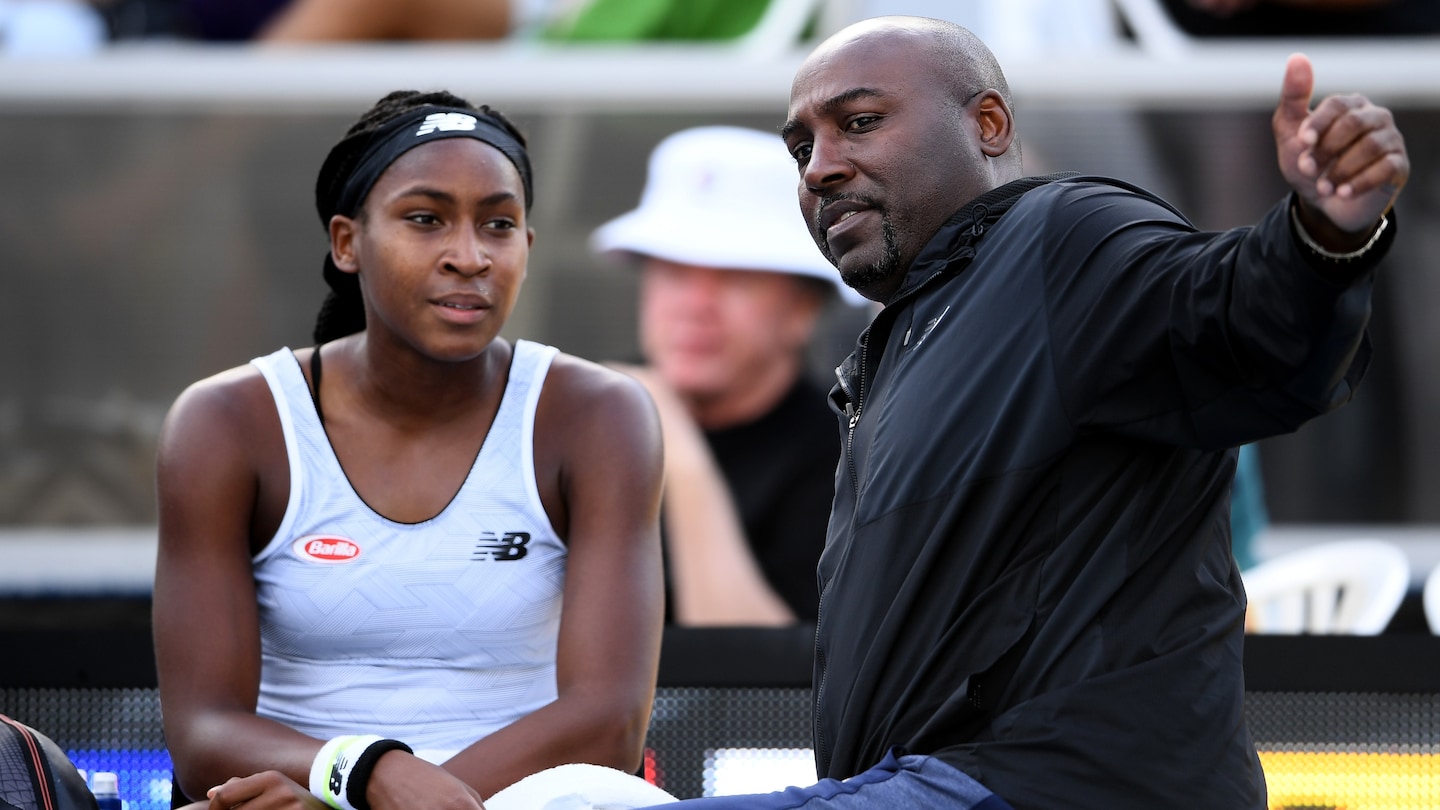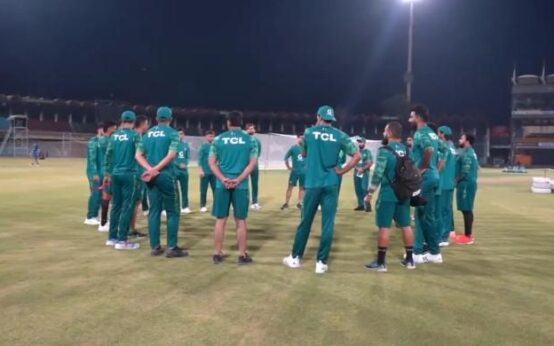But wait, look here: Something else glows from a back corner of the bank. Corey Gauff, that routine TV presence as the father and coach and coaching overseer of Coco Gauff, happens to dwell among those men and women walking around life with the memories of a curious and magical phenomenon. What is it about March Madness, in which so many people can tell of getting to a round of 64, getting clobbered in that round and then rating the whole thing as some precious memory?
“We’re proud of it,” Corey Gauff said recently beneath the gorgeous desert mountains at the Indian Wells tennis paradise, and he meant the 1991 Georgia State Panthers team that stays connected in a manner unimagined back in March 1991: text chain. Together, they’re part of a peculiar reality of NCAA basketball tournaments: They’re really at their very best right now, right at the outset, right when everybody still dreams before reality starts its grouchy whittling.
So when March comes back these days, Mr. Gauff focuses on the Indian Wells-Miami tennis churn but with occasional flecks of nostalgia. He remembers guarding an opposing leading scorer in the conference tournament and fouling him hard on purpose on the first chance just to see whether the guy had any softness in his heart. He remembers Georgia State getting its first bid to the NCAA men’s tournament, envisioning an exotic trip but then getting stationed in the Southeast Region at the Omni in Atlanta, two MARTA stops from its commuter campus. And he remembers seeing the great Nolan Richardson on the other bench, coaching the Arkansas Razorbacks early in their “Forty Minutes of Hell” zenith, and feeling . . .
Was it awe? It wasn’t quite that, and see whether you can spot the brand of confidence that makes Coco Gauff say she never really dreamed of making the top 10 because the top 10 would be insufficient.
“I looked down kind of sideways,” Corey Gauff said, “because he hadn’t recruited me.”
He let out a terrific roar of a laugh.
“I felt like I fit his system.”
Well before Corey Gauff would co-star with former Florida State heptathlete Candi Odom in exquisite turns of parenting, old sports stories in the Palm Beach (Fla.) Post show him as a lavish scorer from Spanish River High in Boca Raton. He began basketball only as a high school sophomore, following on baseball, tennis and football, in which he was a cornerback and a wide receiver and what he calls a “backup-backup” quarterback. He describes his playing style as “hard-nosed” and his high school height as “5-foot-11, but I said I was 6 feet.” The college box scores show him as a sophomore sixth man through one of those improbable glees. Georgia State had posted one winning season among its 28 tries at winning seasons, 12-11 during the disco era in 1975-76, and it had gone 5-23 in 1989-90, a thing so bleak that Gauff refers to it as “5-25” because when you went 5-23, the human memory certainly feels it as 5-25 (or worse).
“That’s the most I ever lost in any sport I ever played,” he said by phone from Florida following Indian Wells, and so most of the Panthers had wearied of being at the school, except that: “Back then, you couldn’t transfer [easily].” So they spent the offseason resourcefully: “What could we do as a team to get ourselves better?” Gauff said. “Amazing that that same core group of guys went from 5-25 to winning the conference.”
In the hard, hard world of college basketball, full of beasts eager to stem your rise, they wriggled themselves to 13-14 and a No. 5 seed in the Trans America Athletic Conference tournament that began March 5, 1991, at Stetson in DeLand, Fla., between Orlando and Daytona Beach. They would play three teams against whom they had gone 0-6 with losses by 15, nine, 13, seven, eight and 15. Georgia State’s all-time win total in the event howled at zero.
By March, though, “We understood better who we were,” Gauff said. That included “a better commitment to playing defense.” He said, “It’s amazing, if you change your attitude, what can happen.” The team had become “a lot more unselfish,” which meant that “as you can imagine, the ball starts moving” — he laughed right there — “starts moving a lot more. The other teams, if they don’t have [good] defensive rotations . . .”
Georgia State knocked off No. 4 Stetson and 6-foot-9 future NBA player Lorenzo Williams, 70-64, in its home arena. “I think we boxed out really well,” Gauff said. In the semifinals, it ran past No. 1 seed Texas San Antonio, 94-84. In the final, it played No. 6 seed Arkansas Little Rock. “We had never beaten them,” Gauff said, before remembering he had been in school only two years so, “They’d never beaten them,” a thought that dredged another laugh. According to a United Press International story from the time, Georgia Southern had lost to Little Rock 17 consecutive times. Yet: “I remember during warmups that we were pretty psyched up because we were on a winning streak and we finally played the way we wanted to play.”
The final score went a blaring 80-60, and the air around the Panthers started going sort of, you know, mad. Phillip Luckydo, who with Chris Collier had led the scoring, told the great Jeff Schultz of the Atlanta Journal-Constitution: “I fell asleep about 3:30 last night. I had to watch ‘SportsCenter’ over and over again to see if it was really true.”
His roommate missed that loop.
“I was probably out partying,” Gauff said, loosing another considerable laugh even as, “There wasn’t much to do in DeLand back in those days.”
One year after Georgia Tech’s Final Four berth, Georgia Tech’s commuter-school neighbor started siphoning off a bit of attention. Georgia State Coach Bob Reinhart was noted for his bold move in leaving the Atlanta Hawks’ staff five years prior for the Georgia State up-Everest construction project and for what the great Jack Wilkinson of the Journal-Constitution called his “omnipresent unlit stogie.”
“I never smoke it, just chew it,” Reinhart told Schultz.
“I don’t think we’ll have to tell anybody on campus anymore who we are,” Collier said.
“Aw, we wanted to be out of town. We kind of got hosed on that deal,” Gauff says now. “The good news, our fans could come to the game.”
Tip-off would happen at noon on the first Friday, giving the Panthers an extra day in the intoxicating ether of the brackets. The school declared a “snow day” on a snowless day and canceled classes. “We welcome you to our bandwagon,” Reinhart said at a news conference. A knot of Georgia State fans came to the Omni, one bringing a sign reading, “BRING ON UNLV,” the mastodon of that season. The Panthers would bring their No. 16 seed in an era of No. 16 seeds almost entirely hopeless, and Arkansas would bring the heft of a 1990 Final Four berth, a commanding giant guard in Todd Day, his excellent backcourt mate Lee Mayberry and the colossal Oliver Miller, 6-9 and 280 pounds.
Gauff’s athlete’s mind still tries to solve that big one.
“A couple of times I tried a finger roll over Oliver Miller,” he said. “I should have tried to drive around him. Probably would have gotten fouled and made it.”
Georgia State went up 15-6 early. Reality arrived in customary waves. Arkansas led 52-35 by halftime and 117-76 by the end. “Their team came to play as hard as they could,” Richardson said that day, “and they started burning out about the 15-minute mark.” And yet, providing what might serve as an emblem of the magical hold of the event, Reinhart said, “I’m just tickled to death to have been here.”
As for Gauff, he etched himself into the annals with a fine stat line: six points, five assists, three steals, two rebounds. And 33 years on, with the memory of March firmly in the bank amid a gathering barrage of company, he left another clue about a confidence that might echo in a certain U.S. Open champion: “I didn’t like the losing part,” he said. “I was foolish enough to think we could beat Arkansas that year.”


 Best Underground Water Leak Detection Equipment 2024
Best Underground Water Leak Detection Equipment 2024  Best Backyard Ideas: Turn Your Outdoor Area Into a Creative and Calm Haven
Best Backyard Ideas: Turn Your Outdoor Area Into a Creative and Calm Haven  Babar, Rizwan are good players but not whole team, says Mohammad Hafeez
Babar, Rizwan are good players but not whole team, says Mohammad Hafeez  Pak vs NZ: Green Shirts aim to bounce back against Kiwis today
Pak vs NZ: Green Shirts aim to bounce back against Kiwis today